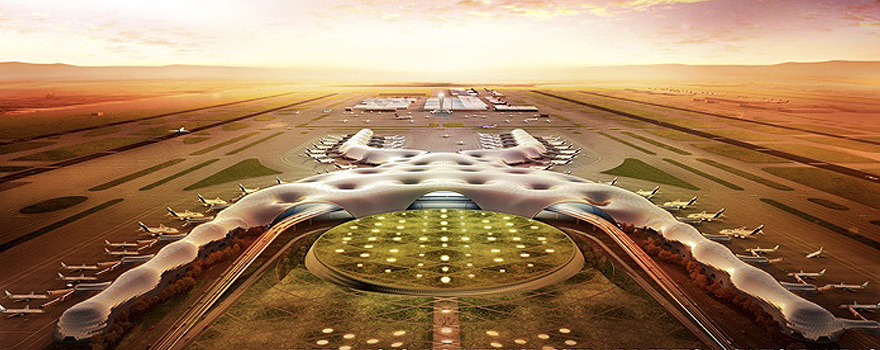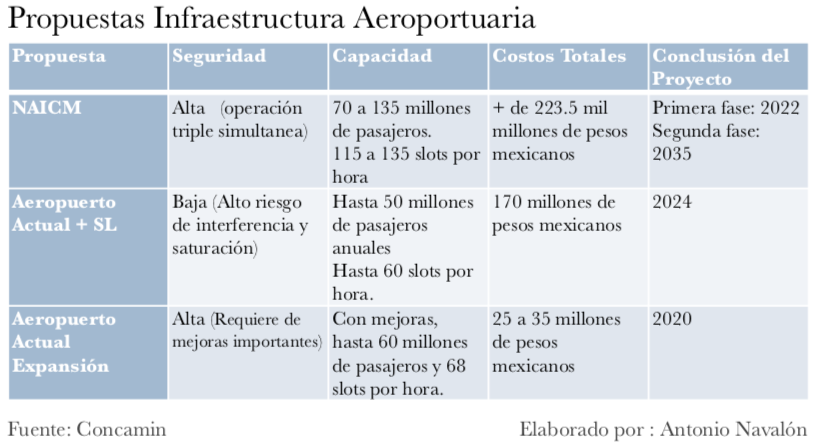Ruta de navegación
Blogs
Entries with label amlo .
The cancellation of the new CDMX airport, already more than 31% built, sows doubts about the economic success of the new administration.
Andrés Manuel López Obrador arrives to the presidency of Mexico facing the economic world, to which he has put up a fight with his advertisement to paralyze the works of the new airport of the capital, despite the fact that a third of the works have already been carried out. The desire to make clear to the economic power who rules the country and to bury what was to be an emblematic bequest of the PRI -whose historical hegemony he hopes to replace with his own party, Morena- may be behind the controversial decision.

▲ Image of the projected NAICM created by Fernando Romero Enterprise, Foster and Partners.
article / Antonio Navalón
The Mexican PRI returned to the presidency of the country in 2012, led by Enrique Peña Nieto, with the promise of making a major investment in public infrastructure that would put Mexico in the world's showcase. The stellar work chosen was the construction of a new airport, whose project was commissioned to architect Norman Foster and which the Institutional Revolutionary Party (PRI) saw as the inheritance that would always be attributed to it.
This great project was to overshadow any negative bequest of Peña Nieto's term, which has been especially marked by corruption cases and historic record violence figures. Although useful for political marketing, increasing the air traffic capacity of Mexico City (CDMX), whose metropolitan area has 23 million inhabitants, is a necessity for boosting the national Economics .
The US$13.3 billion project was one of the largest investments in the country's history. Named Nuevo Aeropuerto Internacional de Ciudad de México (NAICM, later simplified as NAIM) and located at area in Texcoco, a little further away than the current facilities in use, the new infrastructure was to be developed in two phases. The first phase consisted of the construction of a large terminal and three runways, which were initially planned to be ready by 2020, but whose entrance in service had been postponed to 2022 due to construction delays. The second phase would see the construction of three additional runways, plus a second terminal, which would be ready for operation from 2035.
Plans called for NAICM to have the capacity to transport between 70 and 135 million passengers annually, thanks to an operating volume of between 115 and 135 slots per hour. These figures gave a long-term deadline potential benefit of more than $32 billion, according to government estimates.
The project sought first of all to solve the serious air saturation problem suffered by the current Benito Juarez International Airport in Mexico City, caused by the low performance capacity of the two runways that operate simultaneously. In addition, the construction of the NAICM was based on the hope of turning CDMX into a world logistics hub, with the potential to multiply the current airport's cargo transport capacity fourfold.
The level of freight transport in this macro project would be able to reach 2 million tons per year, thus becoming, as its promoters assured, the main distribution center in Latin America. NAICM's ambition, therefore, was to become a reference not only in the American continent but also worldwide, both in the transfer of tourists and in the transport of goods.
NAICM construction began in 2015 and to date 31% of the work has been completed. Although this Degree of completion represents a slight delay compared to the original schedule, the foundation and channeling works are already finished and high Structures intended to hold the wide roof can be seen on the surface. However, despite this progress and the investment already made, the country's new president has announced that he is completely burying the project.
Elections and enquiry
The presidential elections of July 1st were won by the leftist Andrés Manuel López Obrador (inaugurated on December 1st). Former leader of the PRI, thanks to which he served as mayor of the capital, over time he drifted to the left: he first joined the Party of the Democratic Revolution (PRD) and, after losing two elections for the presidency of the country, he created the National Regeneration Movement (Morena). In July, Morena won a majority in both chambers of congress and also conquered the CDMX government, giving AMLO, as the new president is commonly known, broad powers to carry out his policies. While he fell 17 votes short of a qualified majority in the Senate that could change the Constitution, he could gain allies for that purpose.
During the election campaign, Lopez Obrador defended the cancellation of the new airport project alleging its high cost, and raised the possibility that, as an alternative, some improvements could be made to the current airport and the Santa Lucia airport, a military base in the area of the Mexican capital that could be enabled for international flights. But Morena's candidate assured that he would make a enquiry to know the opinion of the Mexican people and that he would abide by the results.
Without waiting to take office as President, Lopez Obrador had Morena carry out this enquiry, which was not organized by the Government but by a political party, and furthermore did not take place in the whole country but in 538 municipalities out of the 2,463 that exist in Mexico. The ballot boxes, set up between October 25 and 28, voted "no" to NAICM: with a participation of only 1% of the national electoral body, 69% voted for the alternative of Santa Lucia and 29% voted to continue the works in Texcoco. López Obrador announced that, in application of result, he will halt the works for the new airport, despite the investment already made.
Some popular movements and also naturalists calling for the preservation of the natural environment applauded the advertisement, but there were also protest marches against the decision in the streets of downtown CDMX. The private sector has greatly regretted the purpose decision to cancel the NAICM project . Leading businessmen in the country and organizations such as the Confederation of Mexican Industrial Chambers (CONCAMIN), which represents 35% of Mexican GDP and 40% of employment in the country, came out in defense of the original project and asked López Obrador to reconsider his decision. Their argument is that any alternative will fall short of the demands of growing air traffic, weighing down the country's development . They also argue that any decision other than continuing with the construction of the NAICM will be more expensive than completing the planned airport [1].
 |
Economic impact
For CONCAMIN, "the current airport lacks the infrastructure and any improvement would not fix the fundamental problems it has", and a bet on the Santa Lucia base "would be a waste of time and money, which will create problems rather than solve them", according to the president of this business association , Francisco Cervantes.
José Navalón, of CONCAMIN's Foreign Trade and International Affairs Commission, of which he is a member, warns that López Obrador's decision will be a major blow to Mexico's macroeconomic and financial system. In his words, "it is still too early to assess possible consequences, but it will be necessary to see if Mexico has the appropriate airport infrastructure, in terms of competitiveness and connectivity, for what is the second largest Economics in Latin America". In any case, for the moment "there has been a problem of lack of confidence in the markets, which has been immediately reflected in the fall of the peso and the markets" [2].
Indeed, while López Obrador was greeted in July with a rise in the markets, because his resounding victory seemed to augur stability for Mexico, his inauguration in December is being accompanied by an "exodus" of investors. The peso has fallen nearly 10% against the dollar in August, the stock market is down 7.6% and in October alone investors sold 2.4 billion dollars in Mexican bonds.
"The main questions that investors are asking today," Navalón continues, "is whether it is safe to invest in Mexico and how often this subject of decisions that do not follow any subject of legality will be taken," as important companies will be affected by the cancellation of a project in progress. He also warns that "the election of Bolsonaro in Brazil, whose profile is a magnet for foreign investment, may directly affect investment in Mexico".
The big question is why López Obrador maintains his decision against the new airport, in spite of the economic penalty it will mean for the Government and the risk of investor flight. We must understand that Mexico has always been a country that has been led by economic power. With its attitude towards NAICM, it aims to clearly mark the line of separation between political and economic power, making it clear that the era of economic power is over. A second reason is that NAICM was going to be the PRI's inheritance and López Obrador probably seeks to destroy any subject of association of this macro project with the party he intends to bury.
REFERENCES
[1] CONCAMIN Document "Airport Proposals" 2018.
[2] Personal interviews with Francisco Cervantes and José Navalón.
